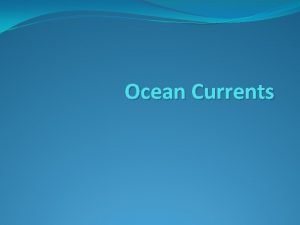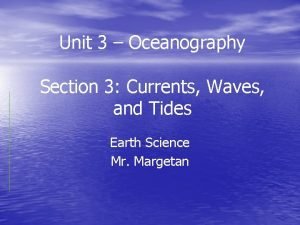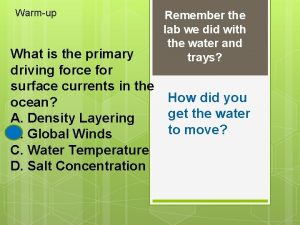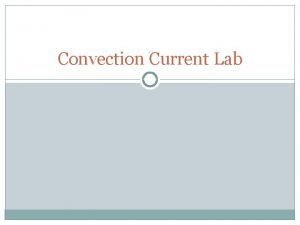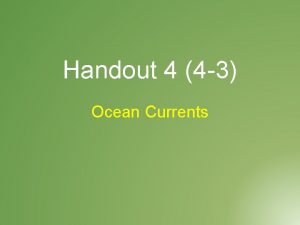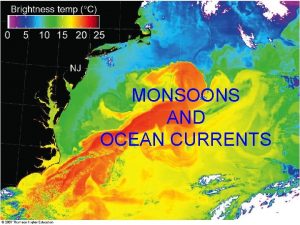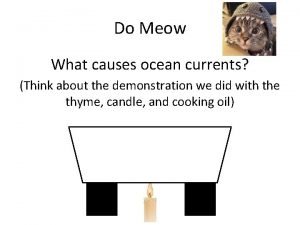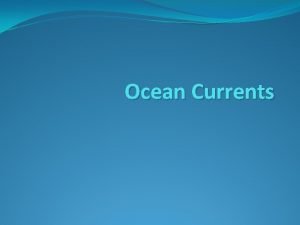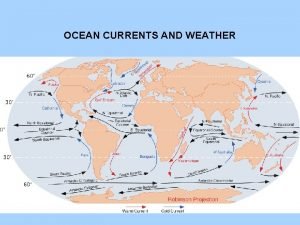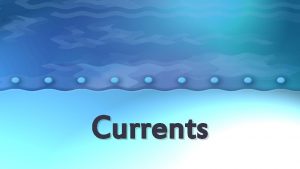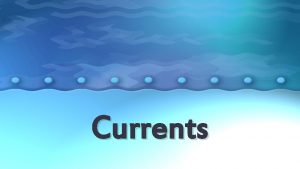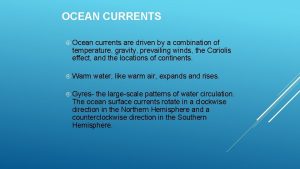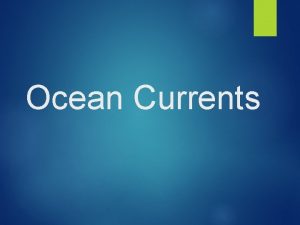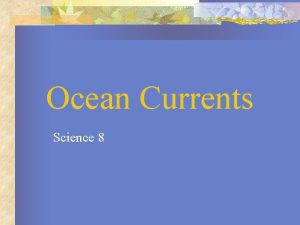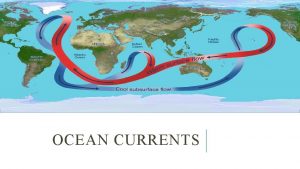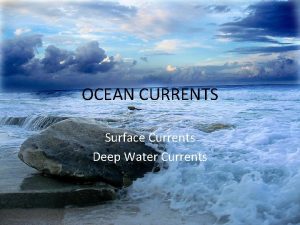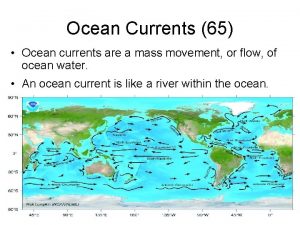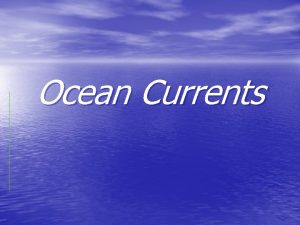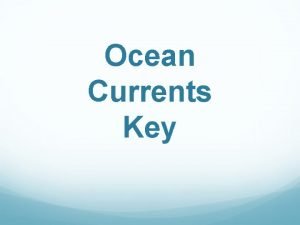Ocean Currents module 11 Ocean currents are driven















- Slides: 15

Ocean Currents- module 11 • Ocean currents are driven by a combination of temperature, gravity, prevailing winds, the Coriolis effect, and the locations of continents. • Warm water, like warm air, expands and rises. • Gyres- the large-scale patterns of water circulation. The ocean surface currents rotate in a clockwise direction in the Northern Hemisphere and a counterclockwise direction in the Southern Hemisphere. • Redistribute heat

Upwelling • Upwelling- as the surface currents separate from one another, deeper waters rise and replace the water that has moved away. • This upward movement of water brings nutrients from the ocean bottom that supports the large populations of producers, which in turn support large populations of fish.

Thermohaline Circulation • Thermohaline circulation- another oceanic circulation that drives the mixing of surface water and deep water. • Scientists believe this process is crucial for moving heat and nutrients around the globe. • Thermohaline circulation appears to be driven by surface waters that contain unusually large amounts of salt.

Thermohaline Circulation • Some of the water that flows from the Gulf of Mexico to the North Atlantic freezes or evaporates, and the salt that remains behind increases the salt concentration of the water. • This cold, salty water is relatively dense, so it sinks to the bottom of the ocean, mixing with deeper ocean waters. • These two processes create the movement necessary to drive a deep, cold current that slowly moves past Antarctica and northward to the northern Pacific Ocean.


Heat Transport • Ocean currents can affect the temperature of nearby landmasses. • For example, England's average winter temperature is approximately 20 ˚ C (36˚F) warmer than Newfoundland, Canada, which is located at a similar latitude.

Lab on Wednesday with Ms. Norton! • https: //www. youtube. com/watch? v=Lk. RQj. Td. T v. FE • Divide into groups with chromebook. Write a script to accompany the video. , explaining thermohaline circulation thoroughly. The dialogue should last the entire video. Be prepared to present to class.

El Nino-Southern Oscillation • Every 3 to 7 years, the interaction of the Earth's atmosphere and ocean cause surface currents in the tropical Pacific Ocean to reverse direction.

El Nino-Southern Oscillation • First, the trade winds near South America weaken. • This weakening allows warm equatorial water from the western Pacific to move eastward toward the west coast of South America. • The movement of warm water and air toward South America suppresses upwelling off the coast of Peru and decreases productivity there, reducing fish populations near the coast. • These periodic changes in wind and ocean currents are collectively called the EL Nino-Southern Oscillation, or ENSO.

ENSO Normal Conditions Wind Direction Wind Strength Precipitation Location Water temperature in eastern Pacific Water temperature in western Pacific Change from normal conditions N/A El Nino Conditions

Review • High productivity and nutrient availability in the ocean occurs in areas with _____ • Which of the following does not drive ocean currents? 1. Salinity 2. Prevailing winds 3. Gravity 4. Precipitation 5. Temperature

Variations in Climate Determine the Dominant Plant Growth Forms of Terrestrial Biomes (Module 12) • Climate affects the distribution of species around the globe. • Organisms possess distinct growth forms due to adaptations to local temperature and precipitin patterns. • Terrestrial biome: a geographic region categorized by a particular combination of average annual temperature, annual precipitation, and distinctive plant growth forms on land

• Aquatic Biomes: an aquatic region characterized by a particular combination of salinity, depth, and water flow.


 Insidan region jh
Insidan region jh Compared with surface currents deep currents are
Compared with surface currents deep currents are Coriolis force effect on ocean currents
Coriolis force effect on ocean currents Ocean currents
Ocean currents What is the primary driving force behind surface currents?
What is the primary driving force behind surface currents? Convection currents ocean
Convection currents ocean Longshore currents move sediment as they _____.
Longshore currents move sediment as they _____. Ocean currents
Ocean currents Cold peruvian current
Cold peruvian current Ocean currents waves and tides
Ocean currents waves and tides Rubber ducks ocean currents activity
Rubber ducks ocean currents activity How many major climate types are there worldwide brainpop
How many major climate types are there worldwide brainpop What are ocean currents
What are ocean currents Ocean currents project
Ocean currents project Ocean currents vocabulary
Ocean currents vocabulary Gyre
Gyre


